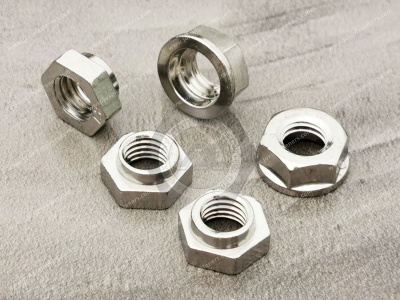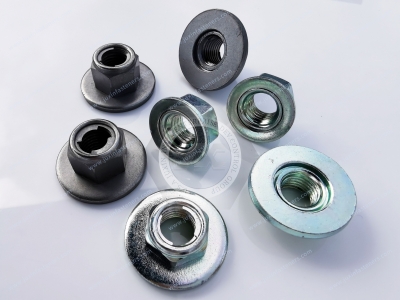Call Us
+86 136 6007 9809
Call Us
+86 136 6007 9809
Jan. 21, 2024
The characteristics of high-strength nuts and application range solutions
The high-strength nut is an important connecting element widely used in construction, machinery, metallurgy, the chemical industry, and other fields. It has the advantages of high strength, corrosion resistance, high-temperature resistance, etc., and is widely used in various significant projects. The nut is a screw cap, a nut made of high-strength steel plate, and high-strength nuts or bolts screwed together for the tightening effect of the parts. High-strength nuts are widely used in sleeve connections or some high-pressure and high-pressure equipment levels, which must be constantly disassembled; various assembly methods are used, and the demand for nuts is very high. Nuts that need to be tightened considerably during the process can be called high-strength nuts. High-strength nuts are standard construction steel manufactured according to the cold heading process, with high exchangeability. Because it refers to the formation at room temperature according to the metal plasticity processing, the deformation of each part of the deformation is large, and the deformation speed is faster. As a result, the performance of raw materials for high-strength nuts is specified more strictly.
Features of high-strength nuts:
1. Easy to assemble, just right, easy to disassemble, recyclable mild steel is used to produce raw materials for manufacturing. The snap structure is simple, with good mechanical equipment performance, disassembly, and dynamic load when loose. This is a promising connection.
2. High-strength nuts are used to torque the special wrench nut so that according to the nut and cushion plate, the bolt results in a vast, controllable preload, the same preload on the connector to increase the preload. Under the action of preload, along the RF connector surface, there will be more friction. If the axial force is lower than the sliding friction, the parts will not roll, and the coupling will not be destroyed. This is the basic principle of high-strength nut coupling.
3. With more robust construction economic benefits. It is easy to construct the project, withstand reasonable force performance and can be arbitrarily disassembled. Sui is essential in high-strength operation; a high-strength nut will not quickly be lost.
High-strength nuts' shape and connection structure are the same as those of ordinary bolts. The main difference between the two is that: familiar bolted connection relies on the rod's compression and shear to transmit the shear strength, and the pretension created by the bolts when the nut is torqued very small, and its influence is not considered; the working principle of high-strength nut connection is to intentionally apply a large amount of pretension to the bolts to make the contact surfaces of the connected parts create a compression force so that there is excellent friction and strength perpendicular to the direction of the screws. This results in a high degree of friction perpendicular to the screw, which is relied upon to transmit the shear strength of the connection. The pre-strength of a high-strength nut is achieved by torquing the nut. The torque and turn methods are generally used for regular high-strength nuts. In the case of torque-shear type high-strength nuts, the pre-strength is controlled by twisting off the end of the bolt.
Bolts for high-strength nut connections are made from high-quality alloy structural steel, grade 10.9S or 8.8S, and heat-treated, and holes for high-strength bolts are drilled. The hole diameter of high-strength bolts for friction-type connections is 1.5 to 2.0 mm larger than the nominal bolt diameter d; the hole diameter of high-strength bolts for pressure-type connections is 1.0 to 1.5 mm larger than the little bolt diameter d.


Classification of high-strength nuts:
1. According to the state of strength, friction and compression types exist.
There is a difference in the design calculation methodology, with friction type high strength nuts having sliding of the plates as the limit of strength, and compression type high strength nuts having sliding of the plates as the limit of everyday use and breaking of the joint as the limit of stability. Friction-type high-strength nuts do not utilize the full potential of the bolt. In practice, friction-type high-strength bolts should be used for critical structures or structures subjected to dynamic loading, especially if the loading causes back-power, where the unused potential of the bolt can be used as a safety reserve. Otherwise, pressure-type high-strength nuts should be used to reduce the cost.
2. According to artistry, two high-strength nuts are twisted-shear type high-strength nuts and macro hexagonal high-strength nuts.
While the high-strength massively hexagonal high-strength nuts belong to the high-strength class of standard screws, the twisted-shear high-strength nuts are an improved version of the massively hexagonal high-strength nuts for better artistry. High-strength nuts must be torqued initially, then finally, with an impact electric wrench or a torque-adjustable electric wrench for initially torquing the high-strength nut. In contrast, the final torquing of the high-strength nut is strictly required, with a torque-shear electric wrench for the final torquing of the twisted-shear high-strength nut and a torque electric wrench for the final torquing of the torque-adjustable high-strength nut. Generally, high-strength bolts can withstand greater loads than ordinary bolts of the same size. Standard bolts are made of Q235 (i.e., A3).
High-strength bolts are made of 45# steel, alloy steel (e.g., 20MnTiB, 35VB), or other high-quality materials and are heat-treated after manufacture to increase their strength.
The difference between the two is the difference in material strength.
1. Raw materials: High-strength bolts are manufactured from high-strength materials. The screw, nut, and washer of a high-strength nut are made of high-strength steel, often 45-gauge, 40-boron, 20-manganese-titanium-boron steel. Ordinary bolts are usually made from Q235 steel.
2. In terms of strength grade, High-strength nuts are increasingly used. Two strength grades, 8.8 and 10.9, are often used, with 10.9 being the most common. The strength grades of ordinary bolts are lower, generally 4.4, 4.8, and 5.6. (8.8S and 10.9S are used exclusively for steel structures.)
First of all, high-strength nuts have essential applications in the construction field. Bolting is a critical part of building structures. High-strength nuts can provide a solid connection to ensure the stability and safety of building structures. Whether it is a high-rise building, a large-span bridge, or the installation of necessary equipment, high-strength nuts are indispensable.
Nut applications in the automotive industry, construction machinery, wind power generation equipment, agricultural machinery foundry, drilling equipment, marine industry, military mining equipment, oil drilling rigs (onshore or offshore), utility tracks, transportation drive systems, metallurgical equipment, rock drilling hammer nuts, etc., as an essential fasteners connectors, generally supporting the use of screws, bolts, used to the two relative separations of the things fixed connection together. Nut standard specifications in the M2 to M36, larger or smaller, are challenging; the material is commonly carbon steel and stainless steel, two categories.
Secondly, high-strength nuts have a wide range of applications in machinery manufacturing. Mechanical equipment usually needs to withstand more significant pressure and load, and the operation process needs to maintain a stable connection. High-strength nuts can provide a more vital locking force to ensure the regular operation of mechanical equipment. For example, the fasteners of automobile engines, aircraft engine connectors, etc., must use high-strength nuts to ensure regular operation.
In addition, high-strength nuts have a wide range of applications in the metallurgical and chemical fields. These industries often need to deal with high temperatures and corrosive substances. High-strength nuts are characterized by high temperature and corrosion resistance and can maintain stable connections in harsh environments. High-strength nuts are widely used in various pipelines, valves, and other connectors in refineries and chemical plants.
In addition to the above fields, high-strength nuts also play an essential role in various industries, such as the energy, aerospace, and ocean engineering fields. In constructing nuclear power plants, high-strength nuts connect multiple vital equipment to ensure the stability and safety of nuclear power plants. In manufacturing spacecraft, high-strength nuts combine various parts of spacecraft to ensure their reliable operation in space. In marine engineering, high-strength nuts connect marine platforms and deep-sea equipment, which can withstand powerful maritime forces.
Please get in touch with us if you want high-quality Metric Medium-Strength Steel Hex Nuts fasteners or technical support for structural design. Thanks.Email:adelajonly@gmail.com
Website: https://www.juxinfasteners.com
Contact Us
Tel.:
+86 020 8621 0320
+86 020 3121 6067
Technical Support:
Navigation
SEND INQUIREY